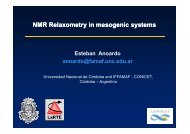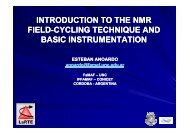Download Program and abstract book - 8th Conference on FFC ...
Download Program and abstract book - 8th Conference on FFC ...
Download Program and abstract book - 8th Conference on FFC ...
You also want an ePaper? Increase the reach of your titles
YUMPU automatically turns print PDFs into web optimized ePapers that Google loves.
Poster 04<br />
Abstract<br />
Applicati<strong>on</strong> of <strong>FFC</strong>-NMR relaxometry to catalyst layer materials of<br />
prot<strong>on</strong> exchange membrane fuel cells<br />
Makoto Yamaguchi a , Akihiro Ohira a,b<br />
a Fuel Cell Cutting-Edge Research Center, Tokyo, Japan<br />
b Nati<strong>on</strong>al Institute of Advanced Industrial Science <str<strong>on</strong>g>and</str<strong>on</strong>g> Technology (AIST), Osaka, Japan<br />
In prot<strong>on</strong> exchange membrane fuel cells catalyst layers work as either a cathode for oxygen<br />
reducti<strong>on</strong> or an anode for hydrogen oxidati<strong>on</strong>. They c<strong>on</strong>sist of platinum catalyst particles<br />
dispersed <strong>on</strong> carb<strong>on</strong> black particles <str<strong>on</strong>g>and</str<strong>on</strong>g> coated with i<strong>on</strong>omer thin films. Applicati<strong>on</strong> of pulsed<br />
field gradient NMR which made great success to measure self diffusi<strong>on</strong> coefficients of the<br />
membranes would be difficult due to their complex structure in nanoscales. Recently we<br />
reported preliminary results <strong>on</strong> NMR relaxometry of the catalyst layers which showed NMRD<br />
profiles quite different from the i<strong>on</strong>omer membranes due to str<strong>on</strong>g interati<strong>on</strong> of prot<strong>on</strong>s with<br />
the platinum particles [1]. However, due to their complex structure more detailed studies are<br />
necessary for their comp<strong>on</strong>ents <str<strong>on</strong>g>and</str<strong>on</strong>g> here we report two recent results <strong>on</strong> applicati<strong>on</strong> of NMR<br />
relaxometry. NMRD profiles were measured at Larmor frequencies from 0.001 to 40 MHz by<br />
using Spinmaster <strong>FFC</strong>-2000 (Stelar s.r.l.).<br />
1. Perfluorinated sulf<strong>on</strong>ic acid i<strong>on</strong>omer membranes at low water c<strong>on</strong>tent: Perrin et al.<br />
observed changes in NMRD profiles by the type of surface interacti<strong>on</strong> as well as water<br />
c<strong>on</strong>tent down to =3.4 (=[H 2 O]/[RSO 3 H]) in the case of Nafi<strong>on</strong> membranes [2,3]. As water<br />
c<strong>on</strong>tent would become lower in the catalyst layers due to diffusi<strong>on</strong> of gaseous reactants, we<br />
measured 1 H NMRD profiles of H-Nafi<strong>on</strong> membranes (DuP<strong>on</strong>t NR212) of =1. The<br />
membranes were evacuated at room temperature <str<strong>on</strong>g>and</str<strong>on</strong>g> sulf<strong>on</strong>ic acid sites are assumed to form<br />
dimers of i<strong>on</strong> pairs as (RSO 3 - H 3 O + ) 2. The 1 H relaxati<strong>on</strong> rates gradually decreased with<br />
temperature <str<strong>on</strong>g>and</str<strong>on</strong>g> the NMRD profiles became less steeper from power law to logarithmic<br />
frequency depenence. They are fitted by formula corresp<strong>on</strong>ding to renormalized Rouse model<br />
[4] which seems to be c<strong>on</strong>sistent with the assumpti<strong>on</strong> of restricted moti<strong>on</strong>s of prot<strong>on</strong>s in<br />
bridged side chains.<br />
2. Effect of acidity <strong>on</strong> prot<strong>on</strong> relaxati<strong>on</strong> by interacti<strong>on</strong> with platinum surface: Prot<strong>on</strong> spin<br />
lattice relaxati<strong>on</strong> rates of aqueous soluti<strong>on</strong>s c<strong>on</strong>tacting platinum particles were found to be<br />
dependent <strong>on</strong> their acidity. In acid soluti<strong>on</strong>s relaxati<strong>on</strong> rates become gradually larger than<br />
water towards higher frequency <str<strong>on</strong>g>and</str<strong>on</strong>g> NMRD profiles are less steep. No significant effect of<br />
associated ani<strong>on</strong>s was identified as surface diffusi<strong>on</strong> of water would not be affected by weak<br />
interacti<strong>on</strong> of diffusi<strong>on</strong> water <str<strong>on</strong>g>and</str<strong>on</strong>g> ani<strong>on</strong>s. In c<strong>on</strong>trast, hydr<strong>on</strong>ium i<strong>on</strong>s c<strong>on</strong>centrated in the<br />
vicinity of the metal surface would str<strong>on</strong>gly affect surface diffusi<strong>on</strong> of water by hydrogen<br />
b<strong>on</strong>d formati<strong>on</strong>.<br />
This work was financially supported by the Ministry of Ec<strong>on</strong>omy, Trade <str<strong>on</strong>g>and</str<strong>on</strong>g> Industry<br />
(METI) <str<strong>on</strong>g>and</str<strong>on</strong>g> the New Energy <str<strong>on</strong>g>and</str<strong>on</strong>g> Industrial Technology Development Organizati<strong>on</strong> (NEDO),<br />
Japan.<br />
[1] Yamaguchi, M., Ohira, A., MRPM11 (2012).<br />
[2] Perrin J.-C., Ly<strong>on</strong>nard, S., Guillermo, A., Levitz, P., J. Phys. Chem. B 110 (2006) 5439-5444.<br />
[3] Perrin J.-C., Ly<strong>on</strong>nard, S., Guillermo, A., Levitz, P., Magn. Res<strong>on</strong>. Imaging 25 (2007) 501-504.<br />
[4] Fatkullin, N., Kimmich, R., Weber, H. W., Phys. Rev. E 47 (1993) 4600-4603.<br />
<str<strong>on</strong>g>8th</str<strong>on</strong>g> <str<strong>on</strong>g>C<strong>on</strong>ference</str<strong>on</strong>g> <strong>on</strong> Fast Field Cycling NMR Relaxometry, Turin 23-25 May 2013




